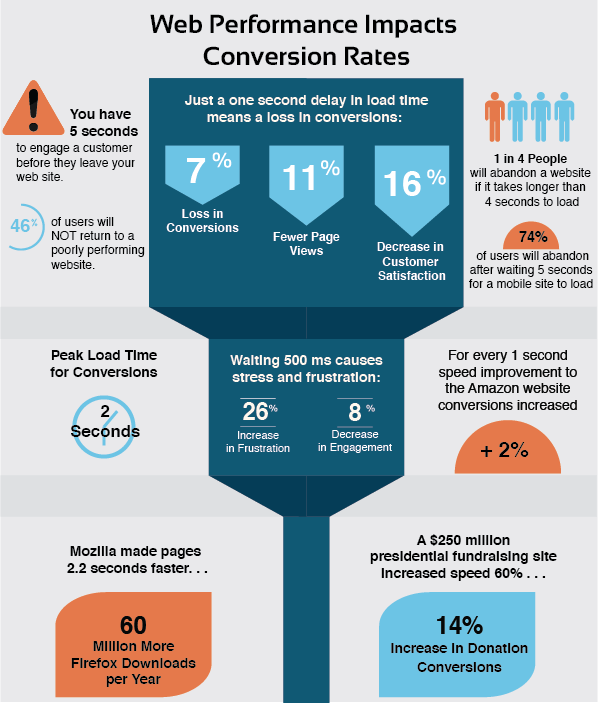Slow Web Page Load Times
We are a society that loves immediate gratification. In most cases we can have all the information we need at a click of a button. We’ve all typed in an URL address, hit return, and then it happens (gasp!)..the dreaded spinner. You are waiting, waiting, waiting and it has been almost 20 seconds. Really? Are we supposed to wait that long for a website to load? Almost 50 % of consumers expect a site to load in 2 seconds or less. We have places to go and people to see!
Online shopping and the overall experience has made the online users wanting websites that load faster. Loadstorm has created an infographic that demonstrates the impact of web performance on customer conversion. Loadstorm says that businesses have 5 seconds to engage an individual before they leave your site and go elsewhere. Every second that passes reduces the amount of customer conversions. No one likes to lose business! This is one of the main reasons why page load times have become vital in creating professional web designs. Did we also mention that Google has hinted that site speed may currently or in the future impact SEO? When Google talks, we listen!
Let’s talk about what can cause painfully slow web page load times.
Coding and Design
Colors, fonts, widgets and plugins all play a role in the speed of your website. The colors and fonts utilized in a website design must be aesthetically pleasing but a professional web design service would know that these components can potentially negatively impact load time.
Here are some examples of website features that may increase load times:
- A website that has excessive colors and themes
- When images that are used are not optimized, they carry all the unnecessary data which slows the page load times;
- Too many widgets and plugins on your website
- Multiple ads that open as a pop up window on the user’s screen
- Graphics or mixed media
A professional web design and development service company should keep all these factors in mind when designing a website that can give optimal performance.
The Customer’s Computer
If your customer has an old beat up computer or mobile device, you can expect your website to load much slower on their devices than if they had a new bright and shiny iMac. Older devices may use memory less efficiently and as a result, they become less responsive and slower to load websites.
Malware
With hackers attacking small business websites on a frequent basis, you need to also think about Malware when looking at load times. If your site is infected with malware, this will effect the load time of your website. Contact a website development company to make sure your site is running Malware free.
Servers
Generally speaking, the higher the performance of your server, the better your website will perform. Most small businesses utilize what is called a “shared server.” This means that your website files are sitting on a server along with the files of other companies. Depending on the hosting company, you may be sharing a server with several thousand other websites. If one website on that server happens to explode with traffic, every website sharing that server receives less resources. Does this slow down your website? You bet! Fortunately for small WordPress websites (those with view counts in the tens of thousands a month), it doesn’t really matter if your server has 1GBb of Ram or 9 GB.
There are other options when it comes to servers, such a Virtual Private Server (“VPS”) or private dedicated server or even. For the small business owner that cannot afford a dedicated server, there are other options such as a managed wordpress hosting solution. A professional web design service company would be able to help determine if this a viable and cost effective option for your company.

